MULE CROSSING: Boulder County Fair Grounds Exhibition
By Meredith Hodges
Good morning ladies and gentlemen. My name is Meredith Hodges, this is my husband, Gary, and my daughter, Dena. We own and operate the Lucky Three Mule Ranch in Loveland, where we raise and train high quality mules and donkeys. We have brought two mules with us today that will demonstrate some of the things that mules of today are doing. In the past, mules were used primarily for packing, pulling and farming. Our modern mules are doing much more. Using top quality mares in mule breeding has noticeably increased the capability of an otherwise maligned animal. The combination of the strength and intelligence of the jack and the athletic ability and beauty of the horse has produced a superior performer in the mule. Before we get on to the exhibition….
 First, this morning, we would like to present Meredith, riding her 16.2 hand Quarter Horse mule, Lucky Three Sundowner, exhibiting the discipline of Dressage through a First Level Test! Sundowner has recently taken the step up to First Level after spending 18 months at Training Level, learning to travel in a cadenced, rhythmic, and balanced fashion. At first glance, this pattern may look rather simple and many of you might think, “Oh, that’s simple!” But I challenge you to actually get out and try to do this. You will find, as is the case with many things… that it is not as easy as it looks. Many hours of training have gone into this animal in order to make this mule look as smooth, balanced, and rhythmic as he is. Though he is under the rider’s direct control, he must appear that he is doing of his own accord.
First, this morning, we would like to present Meredith, riding her 16.2 hand Quarter Horse mule, Lucky Three Sundowner, exhibiting the discipline of Dressage through a First Level Test! Sundowner has recently taken the step up to First Level after spending 18 months at Training Level, learning to travel in a cadenced, rhythmic, and balanced fashion. At first glance, this pattern may look rather simple and many of you might think, “Oh, that’s simple!” But I challenge you to actually get out and try to do this. You will find, as is the case with many things… that it is not as easy as it looks. Many hours of training have gone into this animal in order to make this mule look as smooth, balanced, and rhythmic as he is. Though he is under the rider’s direct control, he must appear that he is doing of his own accord.
Coming up the centerline, the animal should reflect straightness and smoothness of gait with a respectful halt and salute to the judge at the center of the arena. The object of Dressage is the harmonious development of the physique and ability of the equine. As a result, it makes the equine calm, supple, loose, and flexible, but also confident, attentive, and keen, thus achieving perfect understanding with his rider.
As Sundowner moves across the diagonal, he is asked to lengthen his stride and proceed with more determination and energy, then return to the sitting trot submissively and calmly. Mules have a very strong flight reflex and it is only through an understanding between mule and rider that this type of movement can be achieved smoothly. A mule is capable of running through any bit known to man, so it is pointless to try to force this kind of submission. It must come slowly through meticulous training and practice.
A halt for five seconds followed by a walk across the diagonal on a loose rein shows the judge that this animal is indeed relaxed and responsive to his rider’s commands, and that there exists a true repose between them. Mules are quite intelligent and can memorize patterns very quickly. For this reason, the patterns themselves are not trained in. Lucky Three Sundowner won the title in 1984 for World Champion Bridle-Reined mule as a four year old, but it has only been recently through his Dressage training that he has become submissive and genuinely willing to comply.
 Next into the arena we have Meredith driving Lucky Three Mae Bea C.T., a 15 HH molly mule. Driving used to be a matter of necessity rather than pleasure. There was not much need to have the animal do much more than go forward at all three gaits, with the trot being most prevalent, and to back and turn. Mules today are being taught to drive with finesse through training in Dressage. Driving classes that are offered in the shows include Pleasure Driving, Obstacle Driving, Drive & Ride, and Cross Country. All of these classes require a good communication and understanding between mule and driver.
Next into the arena we have Meredith driving Lucky Three Mae Bea C.T., a 15 HH molly mule. Driving used to be a matter of necessity rather than pleasure. There was not much need to have the animal do much more than go forward at all three gaits, with the trot being most prevalent, and to back and turn. Mules today are being taught to drive with finesse through training in Dressage. Driving classes that are offered in the shows include Pleasure Driving, Obstacle Driving, Drive & Ride, and Cross Country. All of these classes require a good communication and understanding between mule and driver.
As in Dressage under saddle, the mule learns to go forward with a free and relaxed stride, responsive to control through the reins and whip. Moving in a balanced frame allows the mule to be responsive to any change in gait or direction. The Dressage driving mule is able to bend in the shafts to follow the arc of a circle around turns. This type of driving takes many hours of meticulous training, but will result in a happy calm, quiet, obedient individual.
When the mule is in balance, he is comfortable with his own body and better able to cope with outside distractions or stress. He is better able to stay quiet enough to work his way through tight obstacles and is ultimately able to move each foot at the request of his driver.
Mae Bea C.T. currently holds the Reserve World Champion Driving Mule title and has for two years. She is only six years old, and as a three year old held the World Champion title for Green Driving. In addition to driving, Mae Bea C.T. has captured over 25 titles in Halter, Western Pleasure, English Pleasure, and Reining. She is currently working at Training Level Dressage and Jumping. She is really quite extraordinary in her accomplishments at such a young age.
At the beginning of this demonstration, I talked a little about those of us who wish to improve on our equestrian skills, but who is more important than our young people!? My daughter, Dena, is riding Mae Bea C.T. today to let you know that there are young people out there who also prefer mules.
Dena will first show you a demonstration of Training Level Test 1 in Dressage. The test itself looks simple enough, but I must again tell you there is more to it than meets the eye. At Training Level, the animal is expected to learn to move forward in a free and cadenced fashion. The movements are kept simple to allow the rider to work on such things as forward motion, cadence, rhythm, and directional changes. The animal learns to circle properly, in an upright position,  and begins to learn submissiveness to the bit. By not throwing too many things at the animal all at once, we are allowed to work on these things in a natural progression that will facilitate an obedient, free-moving, and calm animal. As the training becomes the animal, the animal itself becomes a more dependable and pleasurable mount.
and begins to learn submissiveness to the bit. By not throwing too many things at the animal all at once, we are allowed to work on these things in a natural progression that will facilitate an obedient, free-moving, and calm animal. As the training becomes the animal, the animal itself becomes a more dependable and pleasurable mount.
Jumping is definitely one of the mules’ fortes. The muscling on a mule is equivalent to that of a ballet dancer, and he is so nimble, he can jump over his head from a standstill! Training mules to jump in a smooth fashion must be trained in just as in horses. Many years ago, a mule named Hambone out-jumped every horse in this country. It was at that time that mules were banned from the A.H.S.A. competitions. I would imagine that there were some folks’ egos who just couldn’t take it… being out-jumped by an animal that was supposed to be used for farming and such… but today, it is really not the case anymore. Mules are being trained properly and are exhibiting some incredible skills. Because of the difficulty in training the mules, equestrians who ride mules are faced with a real challenge and should be congratulated for their efforts. We are all keepers of the art. I hope that by letting you see a little of what they can do here today, that some of the old sayings about mules can be put to rest and in its place, arise tolerance and support of a truly marvelous and versatile animal! Thank you very much and good luck with your show.
To learn more about Meredith Hodges and her comprehensive all-breed equine training program, visit LuckyThreeRanch.com, MEREDITH HODGES PUBLIC FIGURE Facebook page, or call 1-800-816-7566. Check out her children’s website at JasperTheMule.com. Also, find Meredith on Pinterest, Instagram, MeWe, YouTube and Twitter.
Covered in TRAINING MULES & DONKEY: A LOGICAL APPROACH TO TRAINING, TRAINING WITHOUT RESISTANCE and EQUUS REVISITED at www.luckythreeranchstore.com.
© 1988, 2016, 2024 Lucky Three Ranch, Inc. All Rights Reserved.



 drawings to acrylic painting to bronze sculpture, from commissioned work to originals, all revering the mule. She has also written a multitude of articles for such publications as The Brayer, a bimonthly publication put out by the American Donkey & Mule Society, Mules and More Magazine, Western Mule Magazine and the Bishop Mule Days program.
drawings to acrylic painting to bronze sculpture, from commissioned work to originals, all revering the mule. She has also written a multitude of articles for such publications as The Brayer, a bimonthly publication put out by the American Donkey & Mule Society, Mules and More Magazine, Western Mule Magazine and the Bishop Mule Days program. Bonnie’s second contribution to the LOVELAND LONGEARS MUSEUM & SCULPTURE PARK at Lucky Three Ranch, titled “Friends,” was a depiction of the three main characters in the Jasper the Mule children’s series: Kylie, Moxie and Jasper. This sculpture was strategically placed at the entrance to the North Barn where the Champion Mules of the Lucky Three Ranch were housed. The people on our tours are always captivated, and smile broadly, when they spot these animated characters exhibited in bronze! Bonnie was my illustrator for the Jasper the Mule series, so we both did a book signing tour together for the launch of the first book that included: Nashville, Dallas (Children’s Hospital and several TV & Radio appearances, and book signings), National Finals Rodeo in Las Vegas and Los Angeles. Those were exciting times!
Bonnie’s second contribution to the LOVELAND LONGEARS MUSEUM & SCULPTURE PARK at Lucky Three Ranch, titled “Friends,” was a depiction of the three main characters in the Jasper the Mule children’s series: Kylie, Moxie and Jasper. This sculpture was strategically placed at the entrance to the North Barn where the Champion Mules of the Lucky Three Ranch were housed. The people on our tours are always captivated, and smile broadly, when they spot these animated characters exhibited in bronze! Bonnie was my illustrator for the Jasper the Mule series, so we both did a book signing tour together for the launch of the first book that included: Nashville, Dallas (Children’s Hospital and several TV & Radio appearances, and book signings), National Finals Rodeo in Las Vegas and Los Angeles. Those were exciting times! Bonnie’s sense of humor is unique and infectious! Mules and More Magazinepublished her stories, mostly involving mules and their appearance in history with their human counterparts. They were always lively and entertaining! What is certain to end in disaster, usually takes you on a long journey that ultimately results in compromise and wide grins. Of course, this is what living with Longears is all about. Either you have a good sense of humor and enjoy the ride, or you DON’T. If you don’t, the joke’s on you! With each individual mule owner, the stories are different, but our introductions to Longears are basically the same. Most humans are not always ready for the pranks of their mules and donkeys! This is the source of Bonnie’s amazing sense of humor with her numerous cartoons and whimsical paintings. Bonnie did a classic painting just for me titled, “I Don’t Know…Maybe I’m Overorganized!” She sure knows me well! Even her way of spelling words adds to the charm of her work. For instance, “sure,” she spells “shure!” My mother once told me I should help her with her spelling. I told her that even Bonnie’s spelling was unique about Bonnie! It is all about “Artistic License!” Then my mother asked if she ever got dressed up when she went OUT? I replied, “Of course! She wears her WHITE overalls for those kinds of events! She DID get some pretty snazzy BLACK overalls from the Draft Horse Club for ‘Black Tie’ events!”
Bonnie’s sense of humor is unique and infectious! Mules and More Magazinepublished her stories, mostly involving mules and their appearance in history with their human counterparts. They were always lively and entertaining! What is certain to end in disaster, usually takes you on a long journey that ultimately results in compromise and wide grins. Of course, this is what living with Longears is all about. Either you have a good sense of humor and enjoy the ride, or you DON’T. If you don’t, the joke’s on you! With each individual mule owner, the stories are different, but our introductions to Longears are basically the same. Most humans are not always ready for the pranks of their mules and donkeys! This is the source of Bonnie’s amazing sense of humor with her numerous cartoons and whimsical paintings. Bonnie did a classic painting just for me titled, “I Don’t Know…Maybe I’m Overorganized!” She sure knows me well! Even her way of spelling words adds to the charm of her work. For instance, “sure,” she spells “shure!” My mother once told me I should help her with her spelling. I told her that even Bonnie’s spelling was unique about Bonnie! It is all about “Artistic License!” Then my mother asked if she ever got dressed up when she went OUT? I replied, “Of course! She wears her WHITE overalls for those kinds of events! She DID get some pretty snazzy BLACK overalls from the Draft Horse Club for ‘Black Tie’ events!” of many works of art that we proudly display at the LOVELAND LONGEARS MUSEUM & SCULPTURE PARK at Lucky Three Ranch! As her biggest fan, my Bonnie Shields Gallery is quite extensive!
of many works of art that we proudly display at the LOVELAND LONGEARS MUSEUM & SCULPTURE PARK at Lucky Three Ranch! As her biggest fan, my Bonnie Shields Gallery is quite extensive! This book will live on as one of her greatest accomplishments.
This book will live on as one of her greatest accomplishments.
 Most of the world’s calendars begin with New Year’s, but a mule lover’s calendar begins and ends with Bishop Mule Days held in Bishop, California, over Memorial Day weekend each year. This year marked the 17th Annual Mule Days Celebration with over 600 mules participating in everything from the parade to packing to steer roping and jumping. But Bishop Mule Days is more than just a mule show. It is an annual rendezvous of mule lovers from all over the world. It is an opportunity for these people to come together, exchange ideas, demonstrate their talents and pay their respects to the one animal most responsible for the building of this great country of ours – the mule!
Most of the world’s calendars begin with New Year’s, but a mule lover’s calendar begins and ends with Bishop Mule Days held in Bishop, California, over Memorial Day weekend each year. This year marked the 17th Annual Mule Days Celebration with over 600 mules participating in everything from the parade to packing to steer roping and jumping. But Bishop Mule Days is more than just a mule show. It is an annual rendezvous of mule lovers from all over the world. It is an opportunity for these people to come together, exchange ideas, demonstrate their talents and pay their respects to the one animal most responsible for the building of this great country of ours – the mule! Just as the mule has suffered great injustice to his character throughout the ages, so have his admirers and advocates. Stories and rumors have repeatedly portrayed the mule as an unattractive, stubborn creature, but modern day mule lovers have found that these rumors are simply not true. Fast breaking and gross impatience are probably the underlying reasons for such ignorant remarks. Mule lovers today are doing their level best to educate the general public about the true nature of the mule. The simple fact is that he’s generally better than the horse out of which he came, and much more personable!
Just as the mule has suffered great injustice to his character throughout the ages, so have his admirers and advocates. Stories and rumors have repeatedly portrayed the mule as an unattractive, stubborn creature, but modern day mule lovers have found that these rumors are simply not true. Fast breaking and gross impatience are probably the underlying reasons for such ignorant remarks. Mule lovers today are doing their level best to educate the general public about the true nature of the mule. The simple fact is that he’s generally better than the horse out of which he came, and much more personable! The hard work and dedication of the owners, Dr. Robert and Debbie Miller and trainer of “Jord Ass Jean” was also quite apparent; she exhibited the grace and agility of a truly fine animal. Congratulations on tying for World Champion Performance Mule! It was well earned. Not to be outdone by horseracing, mule-racing fans cheered the victory of Cajun Queen, owned by J.P. Rogers, as the World Champion Running Mule. She was indeed a queen! Demonstrating speed and skill, the World Champion Packer was awarded to Tony Holdridge of the Red’s Meadows Pack Outfit. He did it so smoothly! The best for the best – good mules need a good farrier and Lee Green was where it’s at! Congratulations to our World Champion Farrier! Is it that wonderfully loud shirt, or was it the mule? Congratulations to Johnny Enos and Poco Streak, the 1986 World Champion Working Mule!
The hard work and dedication of the owners, Dr. Robert and Debbie Miller and trainer of “Jord Ass Jean” was also quite apparent; she exhibited the grace and agility of a truly fine animal. Congratulations on tying for World Champion Performance Mule! It was well earned. Not to be outdone by horseracing, mule-racing fans cheered the victory of Cajun Queen, owned by J.P. Rogers, as the World Champion Running Mule. She was indeed a queen! Demonstrating speed and skill, the World Champion Packer was awarded to Tony Holdridge of the Red’s Meadows Pack Outfit. He did it so smoothly! The best for the best – good mules need a good farrier and Lee Green was where it’s at! Congratulations to our World Champion Farrier! Is it that wonderfully loud shirt, or was it the mule? Congratulations to Johnny Enos and Poco Streak, the 1986 World Champion Working Mule! As more people are educated about mules, we see more participants in Bishop Mule Days. Ordinarily Bishop is a town of only 4000 people, but streets were lined with 50,000 spectators for the Mule Days Parade, the largest non-motorized parade in the world. In 1986, the parade consisted of 240 entries. Among those entries were real diehards such as the Vision Quest Wagon Train and Tindell Wagon Train. Both wagon trains travelled over 300 miles to take part in the Bishop Mule Days Celebration. The impressions they left along the way will probably go down in history. Once arrived, the young adults from Vision Quest gave us an extra-special treat with their multi-talented marching drill team. Our deepest thanks for their special contribution!
As more people are educated about mules, we see more participants in Bishop Mule Days. Ordinarily Bishop is a town of only 4000 people, but streets were lined with 50,000 spectators for the Mule Days Parade, the largest non-motorized parade in the world. In 1986, the parade consisted of 240 entries. Among those entries were real diehards such as the Vision Quest Wagon Train and Tindell Wagon Train. Both wagon trains travelled over 300 miles to take part in the Bishop Mule Days Celebration. The impressions they left along the way will probably go down in history. Once arrived, the young adults from Vision Quest gave us an extra-special treat with their multi-talented marching drill team. Our deepest thanks for their special contribution! Sunday afternoon, Wadi, an Appaloosa mule, was chosen for the part. Congratulations, Wadi! In addition, Dix Country Pictures will also be putting together a documentary about the Bishop Mule Days Celebration. With their enthusiastic help, we should be able to reach more people than ever in praise of mules! In addition to the actual mule show, special events and people are an important part of Bishop Mule Days. The Governor of California, George Deukmejian participated in the parade and later held a press conference. Ted Dawson, award-winning sportscaster for KABC-PV Los Angeles, was honored as Grand Marshall for the Bishop Mule Days Parade. Struck with “Mule Fever,” enthusiastic Ted also participated in many mule events, with his memorable performance being in the musical tires class. Surely, it is a time he will never forget…and neither will we! Semi-truck pulls, steer packing, large hitch demonstrations, and races with eight to ten mules per wagon were just a few of many special events enjoyed by spectators that year.
Sunday afternoon, Wadi, an Appaloosa mule, was chosen for the part. Congratulations, Wadi! In addition, Dix Country Pictures will also be putting together a documentary about the Bishop Mule Days Celebration. With their enthusiastic help, we should be able to reach more people than ever in praise of mules! In addition to the actual mule show, special events and people are an important part of Bishop Mule Days. The Governor of California, George Deukmejian participated in the parade and later held a press conference. Ted Dawson, award-winning sportscaster for KABC-PV Los Angeles, was honored as Grand Marshall for the Bishop Mule Days Parade. Struck with “Mule Fever,” enthusiastic Ted also participated in many mule events, with his memorable performance being in the musical tires class. Surely, it is a time he will never forget…and neither will we! Semi-truck pulls, steer packing, large hitch demonstrations, and races with eight to ten mules per wagon were just a few of many special events enjoyed by spectators that year. All the way from Colorado, the Coors Belgian Hitch gave several impressive performances during the weekend show. Under the steady hand of Jim Hilgendorf, the Belgians exhibited an awesome display of power and grace. Monty Montana, 1978 Grand Marshall of the Mule Days Parade, returned to tantalize the crowd with his intricate rope tricks and trick riding, a wonderful contribution to Mule Days. Even the United States Armed Forces were represented at Bishop Mule Days – two were from the Mountain Warfare Training Center. Rumor has it that mules will still be replacing some modes of transportation in the more mountainous regions. The overall feeling is that mules would be more practical and economical for this type of use.
All the way from Colorado, the Coors Belgian Hitch gave several impressive performances during the weekend show. Under the steady hand of Jim Hilgendorf, the Belgians exhibited an awesome display of power and grace. Monty Montana, 1978 Grand Marshall of the Mule Days Parade, returned to tantalize the crowd with his intricate rope tricks and trick riding, a wonderful contribution to Mule Days. Even the United States Armed Forces were represented at Bishop Mule Days – two were from the Mountain Warfare Training Center. Rumor has it that mules will still be replacing some modes of transportation in the more mountainous regions. The overall feeling is that mules would be more practical and economical for this type of use. Each year, before the Saturday and Sunday evening performances, a very special lady, Nita Vick makes her contribution to Bishop Mule Days. Affectionately known as “Sarge,” she takes rookie volunteers and shapes them into the Bishop Mule Days Drill Team. No one would know from the actual performances that this team had the absolute minimum practice time, only one hour of practice before the performance on Saturday and only one hour before practice on Sunday! Their performance “Under the Flags” is a sight to see!
Each year, before the Saturday and Sunday evening performances, a very special lady, Nita Vick makes her contribution to Bishop Mule Days. Affectionately known as “Sarge,” she takes rookie volunteers and shapes them into the Bishop Mule Days Drill Team. No one would know from the actual performances that this team had the absolute minimum practice time, only one hour of practice before the performance on Saturday and only one hour before practice on Sunday! Their performance “Under the Flags” is a sight to see! Mule Days is the most important American Association Show – it appeals to everyone in some way. Western cuisine, Western art shows and Western dances add to the overall picture of Bishop Mule Days. Fiddlers across America rosin up their bows for the Mule Days Fiddling Contest. As they wandered the grounds serenading the crowds, they were joined in harmony by singing donkeys and mules, and dancing exhibitions and spectators. A fun time was had by all! Bishop Mule Days is more than just a mule show. The area around Bishop is filled with mountain lakes and streams and offers backpacking and hiking, fishing, swimming and even skiing. Couple this with unique and spectacular entertainment and you have the opportunity for the time of your life! Memorial Day weekend is the beginning of the year for these maligned animals and the unique people who love them!
Mule Days is the most important American Association Show – it appeals to everyone in some way. Western cuisine, Western art shows and Western dances add to the overall picture of Bishop Mule Days. Fiddlers across America rosin up their bows for the Mule Days Fiddling Contest. As they wandered the grounds serenading the crowds, they were joined in harmony by singing donkeys and mules, and dancing exhibitions and spectators. A fun time was had by all! Bishop Mule Days is more than just a mule show. The area around Bishop is filled with mountain lakes and streams and offers backpacking and hiking, fishing, swimming and even skiing. Couple this with unique and spectacular entertainment and you have the opportunity for the time of your life! Memorial Day weekend is the beginning of the year for these maligned animals and the unique people who love them!
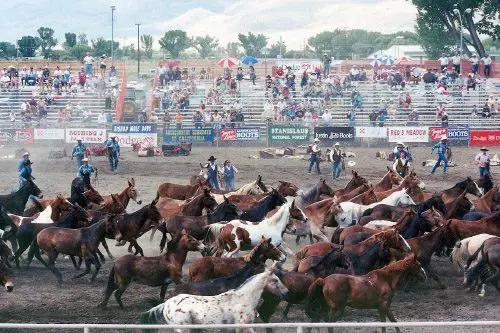




 By Meredith Hodges
By Meredith Hodges Over 600 mules competed in more than 100 different events, including packing scrambles, English and Western classes and games, mule shoeing and comedy and specialty acts. As mules have progressed in their unique abilities, the art of Dressage has been added to the agenda. Lucky Three Sundowner of the Lucky Three Ranch in Loveland, Colorado, was invited to exhibit his grace and ability toward dance in an exhibition during the Sunday afternoon performance. He was the highest level Dressage mule to perform at Bishop this year. Lucky Three Mae Bea C.T. preceded the exhibition by winning the Mule Jumping class with no faults!
Over 600 mules competed in more than 100 different events, including packing scrambles, English and Western classes and games, mule shoeing and comedy and specialty acts. As mules have progressed in their unique abilities, the art of Dressage has been added to the agenda. Lucky Three Sundowner of the Lucky Three Ranch in Loveland, Colorado, was invited to exhibit his grace and ability toward dance in an exhibition during the Sunday afternoon performance. He was the highest level Dressage mule to perform at Bishop this year. Lucky Three Mae Bea C.T. preceded the exhibition by winning the Mule Jumping class with no faults! During the Saturday and Sunday performances, Bobby Tanner and friends reenacted the old 20-mule team hitch exhibition with mules that had only been hitched together since the preceding Monday afternoon! Such skill and Mulemanship is a sight to see…for sure! Another skillful performance was demonstrated by the Bishop Mule Days Drill Team comprised of exhibitors who practiced only once before each performance over the weekend under the strict and skillful command of Nita Vick, fondly known as “Sarge.” Pack scrambles, chariot races and comedy packing kept the audience in suspense and stitches with their wild and crazy antics. Rodeo announcer Bob Tallman added still more fun and excitement to the weekend events with his outlandish quips and stories. Other highlights included the Country Western dances on Friday, Saturday and Sunday nights, preceded on Thursday night by hit songwriter Michael Martin Murphy, who captured the audiences with hit tunes from past, present, and future recording albums. Western artists, craftsmen and salesmen displayed their wares throughout the weekend with a wide variety of items and art from past to present day. Bishop merchants store windows were painted in celebration of “Mules” and mule memorabilia could be found everywhere!
During the Saturday and Sunday performances, Bobby Tanner and friends reenacted the old 20-mule team hitch exhibition with mules that had only been hitched together since the preceding Monday afternoon! Such skill and Mulemanship is a sight to see…for sure! Another skillful performance was demonstrated by the Bishop Mule Days Drill Team comprised of exhibitors who practiced only once before each performance over the weekend under the strict and skillful command of Nita Vick, fondly known as “Sarge.” Pack scrambles, chariot races and comedy packing kept the audience in suspense and stitches with their wild and crazy antics. Rodeo announcer Bob Tallman added still more fun and excitement to the weekend events with his outlandish quips and stories. Other highlights included the Country Western dances on Friday, Saturday and Sunday nights, preceded on Thursday night by hit songwriter Michael Martin Murphy, who captured the audiences with hit tunes from past, present, and future recording albums. Western artists, craftsmen and salesmen displayed their wares throughout the weekend with a wide variety of items and art from past to present day. Bishop merchants store windows were painted in celebration of “Mules” and mule memorabilia could be found everywhere!

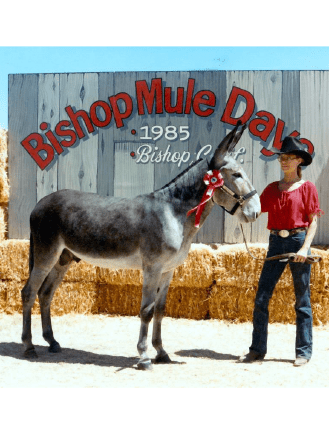 By Meredith Hodges
By Meredith Hodges Bishop Mule Days always has something for everyone. Mule lovers, their friends and family can enjoy fine Western cuisine, games, dancing and good conversation in addition to the show itself. The celebration is kicked off by three mule shows on Friday—there were over 90 different classes and events for competitors. They included: Pleasure classes, Reining classes, Trail, Musical Tires, Barrel Racing and Pole Bending. Also, Jumping, Cattle Penning, Steer Stopping, Team Roping, and a Balloon Bust. For the packers: Pack Train classes, Packing contests, Box Hitch and Diamond Hitch packing contests (pro and non-pro), Team Packing and the Team Packing Scramble, which you must see to believe!
Bishop Mule Days always has something for everyone. Mule lovers, their friends and family can enjoy fine Western cuisine, games, dancing and good conversation in addition to the show itself. The celebration is kicked off by three mule shows on Friday—there were over 90 different classes and events for competitors. They included: Pleasure classes, Reining classes, Trail, Musical Tires, Barrel Racing and Pole Bending. Also, Jumping, Cattle Penning, Steer Stopping, Team Roping, and a Balloon Bust. For the packers: Pack Train classes, Packing contests, Box Hitch and Diamond Hitch packing contests (pro and non-pro), Team Packing and the Team Packing Scramble, which you must see to believe! There was an Individual Packing Scramble for those wild and wooly mountain men or women who preferred to “go it light,” Western Saddle Races for those who wouldn’t be caught dead sitting on a postage stamp, and Forging and Hot Shoeing for our more artistic farriers. All these events and more were narrated by the “Man with the Magic Voice,” Bob Tallman from Reno, Nevada. He is one of many extra-special people who participated in this year’s Mule Days Celebration.
There was an Individual Packing Scramble for those wild and wooly mountain men or women who preferred to “go it light,” Western Saddle Races for those who wouldn’t be caught dead sitting on a postage stamp, and Forging and Hot Shoeing for our more artistic farriers. All these events and more were narrated by the “Man with the Magic Voice,” Bob Tallman from Reno, Nevada. He is one of many extra-special people who participated in this year’s Mule Days Celebration. the French archives as early as 1121. The breed has been protected by the French government and has remained pure for 300 years. Sonnette was one of only 60 Poitou donkeys in existence in 1985 and the only one of her kind in the United States. Her companion Savane was one of an estimated 150 Mulassiers in existence in 1985 and the only one of her kind in the United States. Mulassiers are a powerful draft horse used exclusively to breed with the Poitou ass to produce the Poitou mule, that has been extensively used in agriculture in France for hundreds of years. Seeing these two extremely rare animals was a very special treat indeed!
the French archives as early as 1121. The breed has been protected by the French government and has remained pure for 300 years. Sonnette was one of only 60 Poitou donkeys in existence in 1985 and the only one of her kind in the United States. Her companion Savane was one of an estimated 150 Mulassiers in existence in 1985 and the only one of her kind in the United States. Mulassiers are a powerful draft horse used exclusively to breed with the Poitou ass to produce the Poitou mule, that has been extensively used in agriculture in France for hundreds of years. Seeing these two extremely rare animals was a very special treat indeed!
 The following is a list of points that I used in my pursuit for “Mule” acceptance into the national equestrian organizations such as the American Horse Show Association, The United States Dressage Federation, the United States Eventing Association and ultimately the United States Equestrian Federation (A.H.S.A. replacement).
The following is a list of points that I used in my pursuit for “Mule” acceptance into the national equestrian organizations such as the American Horse Show Association, The United States Dressage Federation, the United States Eventing Association and ultimately the United States Equestrian Federation (A.H.S.A. replacement). 



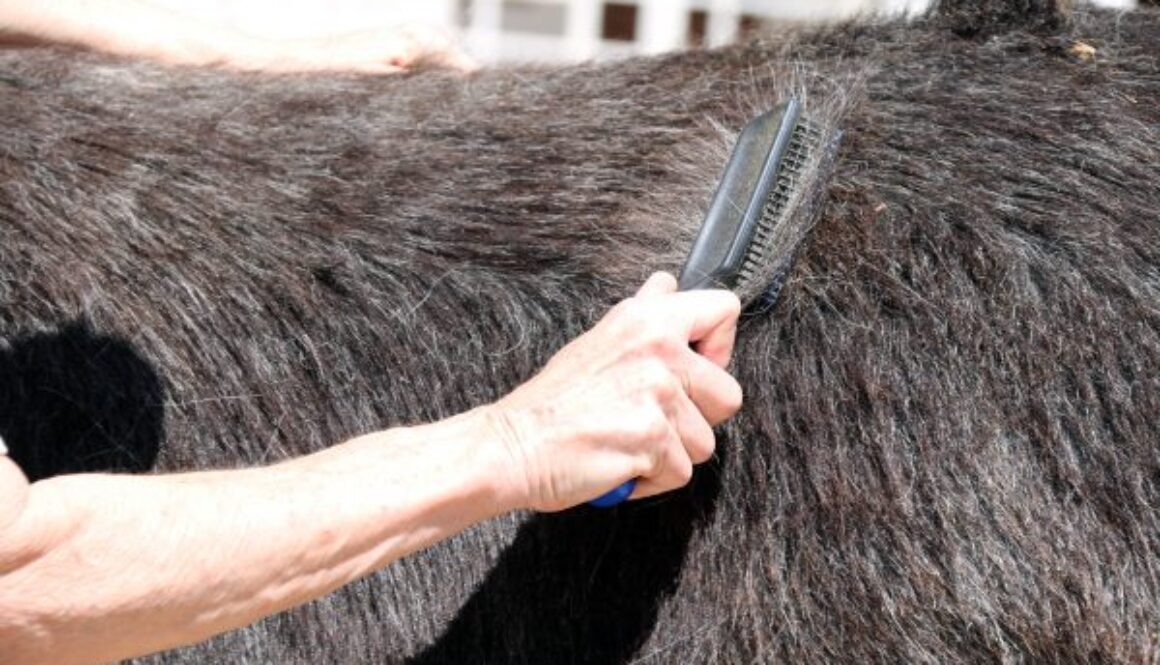
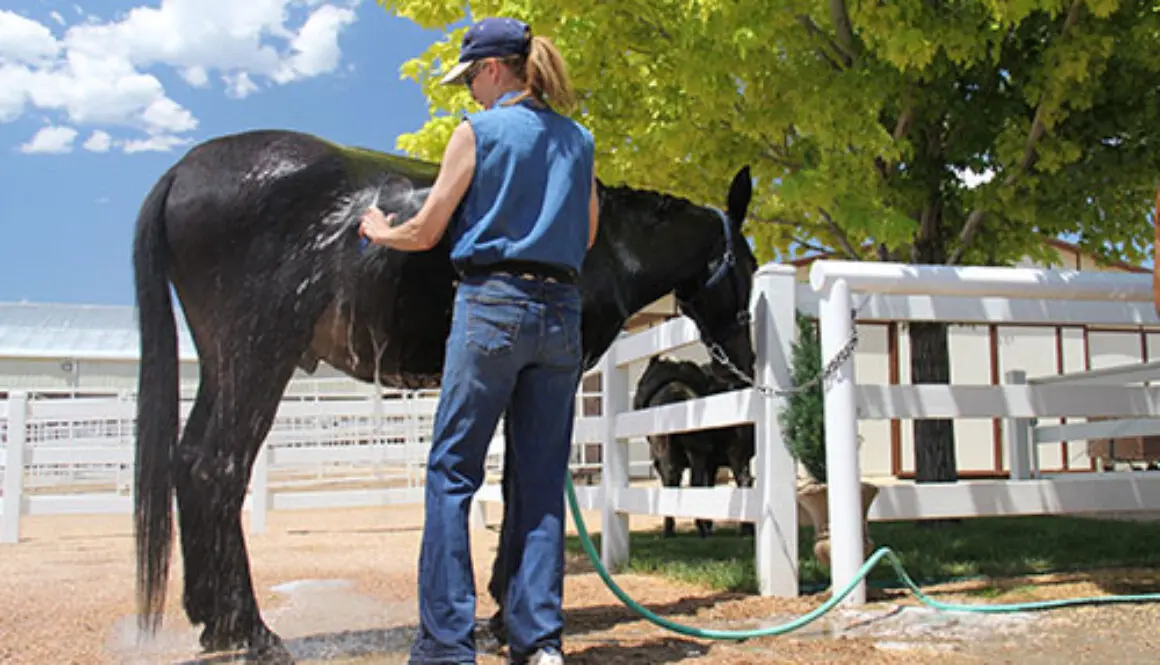

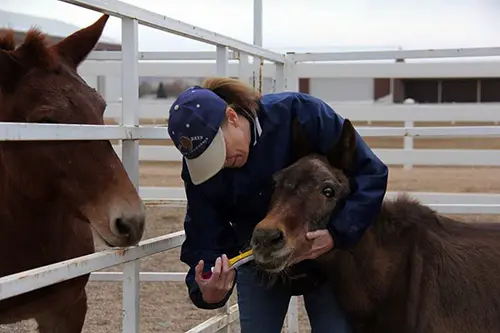
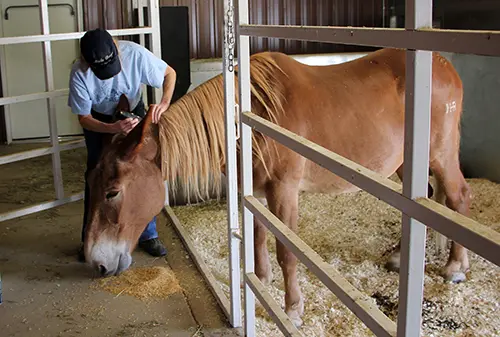
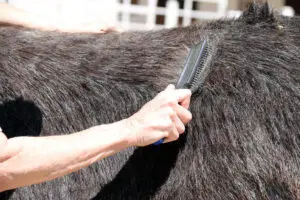 After grooming the left side, move to the right side. Brush the head with a Dandy brush and use a multi-bristled human hairbrush on the mane and tail. By adding a little Johnson’s Baby oil to the mane and tail during grooming, you can train a mane to fall to one side and keep other equines from chewing on manes and tails. Finish with a soft body brush. Finally, use the grooming cloth to wipe around the ears, face, eyes, nose, lips, sheath (if it’s a male) and the dock of the tail.
After grooming the left side, move to the right side. Brush the head with a Dandy brush and use a multi-bristled human hairbrush on the mane and tail. By adding a little Johnson’s Baby oil to the mane and tail during grooming, you can train a mane to fall to one side and keep other equines from chewing on manes and tails. Finish with a soft body brush. Finally, use the grooming cloth to wipe around the ears, face, eyes, nose, lips, sheath (if it’s a male) and the dock of the tail.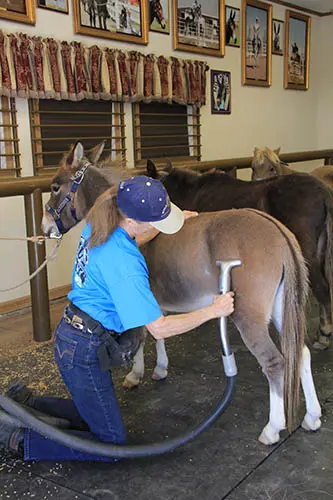
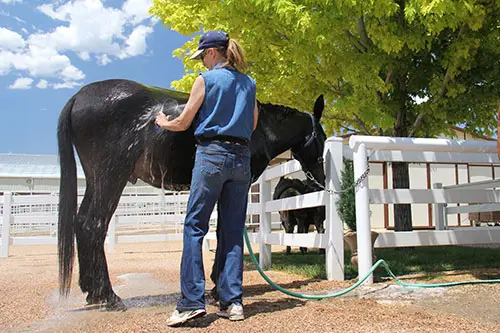
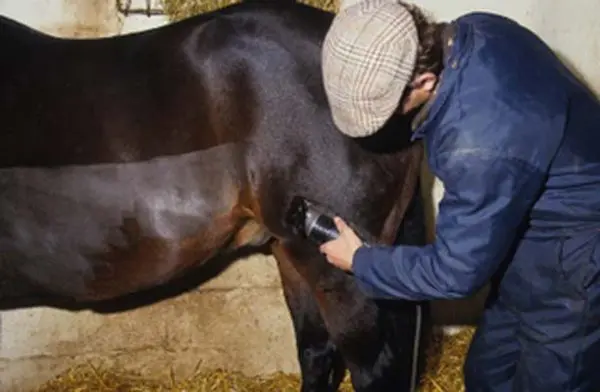
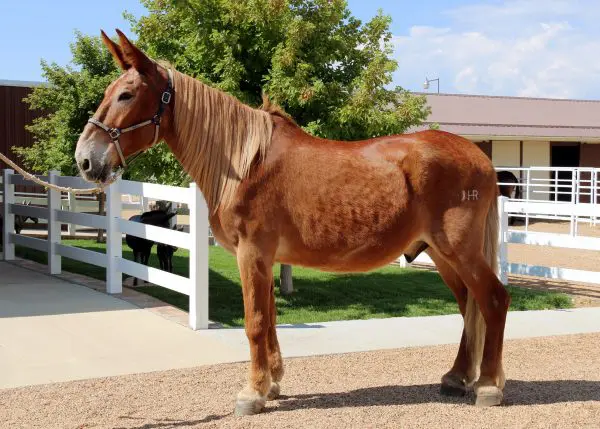
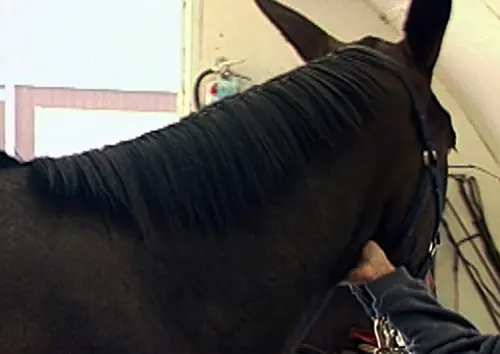
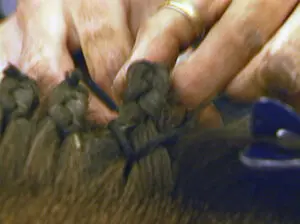 You can spritz a little water and hair spray to make the hair easier to handle. The quickest way to secure the braids is by using tiny rubber bands. It’s also very easy to do and it’s great for one-day shows or quick changes between classes.
You can spritz a little water and hair spray to make the hair easier to handle. The quickest way to secure the braids is by using tiny rubber bands. It’s also very easy to do and it’s great for one-day shows or quick changes between classes.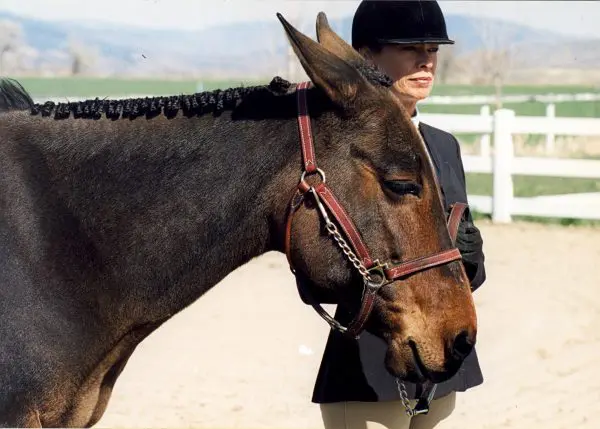
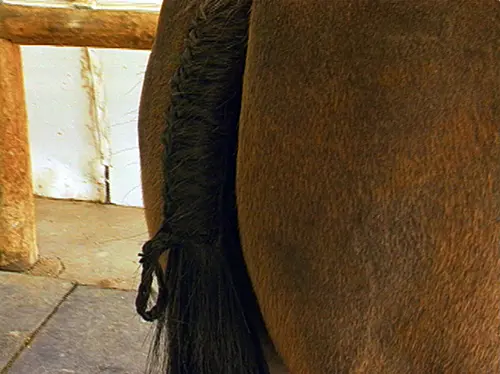

 By Meredith Hodges
By Meredith Hodges In order to remain an integral part of the A.H.S.A, once we were accepted, we are expected to meet certain criteria. First, our breed organization must have been incorporated in the United States a minimum of five years. Since the American Donkey & Mule Society was founded in 1967, we had already met these criteria.
In order to remain an integral part of the A.H.S.A, once we were accepted, we are expected to meet certain criteria. First, our breed organization must have been incorporated in the United States a minimum of five years. Since the American Donkey & Mule Society was founded in 1967, we had already met these criteria. records on stock for the purpose of a traceable ancestry and to monitor the accomplishments of our athletic champions. Obviously, registering animals improves the chances to help you monitor the health and well being of your animal. A traceable ancestry gives us the opportunity to explore and examine the strengths and weaknesses of our breeding programs and other related research. Monitoring the successful accomplishments of our champions allows us to set new goals and new challenges for our Longears and keeps them in a favorable light in the public eye. These things are all-important to the stability and growth of our industry. With a well-organized registry drive, we could, no doubt, meet this second criterion with no problem.
records on stock for the purpose of a traceable ancestry and to monitor the accomplishments of our athletic champions. Obviously, registering animals improves the chances to help you monitor the health and well being of your animal. A traceable ancestry gives us the opportunity to explore and examine the strengths and weaknesses of our breeding programs and other related research. Monitoring the successful accomplishments of our champions allows us to set new goals and new challenges for our Longears and keeps them in a favorable light in the public eye. These things are all-important to the stability and growth of our industry. With a well-organized registry drive, we could, no doubt, meet this second criterion with no problem. The third criterion was, perhaps, the one that is gave us the biggest problem: “Competitions restricted to a breed or discipline must have been held in at least 20 events during the year immediately preceding an application for recognition either at A.H.S.A.-approved events or at events approved by the breed or discipline.” This alone, is not a problem, since we definitely hold at least 20 events a year that could stand the scrutiny of A.H.S.A. approval. To remain in the A.H.S.A. we must follow up by having “a minimum of 25% of the competitions restricted to a breed or discipline held at A.H.S.A. events annually.” We needed people and clubs to take responsibility for seeing that these competitions continue to survive and thrive in the corning years.
The third criterion was, perhaps, the one that is gave us the biggest problem: “Competitions restricted to a breed or discipline must have been held in at least 20 events during the year immediately preceding an application for recognition either at A.H.S.A.-approved events or at events approved by the breed or discipline.” This alone, is not a problem, since we definitely hold at least 20 events a year that could stand the scrutiny of A.H.S.A. approval. To remain in the A.H.S.A. we must follow up by having “a minimum of 25% of the competitions restricted to a breed or discipline held at A.H.S.A. events annually.” We needed people and clubs to take responsibility for seeing that these competitions continue to survive and thrive in the corning years. In order to remain in the A.H.S.A., there are only 2 more requirements:
In order to remain in the A.H.S.A., there are only 2 more requirements: However, it isn’t any more so than any other “new” experience. There are many benefits to be gained by joining, and the most important of all was the overall unification of the entire Equine Industry including all breeds and disciplines. Our world is composed of billions of people with many diversified interests. To see that each different interest has the best chance for growth and development, all of those with that particular interest should ban together in support for its very survival. Dissention and arguments within an industry are counter-productive. Those who wanted to see mules and donkeys accepted by the A.H.S.A. as a division were encouraged to write me letters, cards and even call me at the Lucky Three Ranch to let me know their feelings. We wanted to begin the organization for this action. I felt that if I did not receive any responses to this request, I could only assume that our industry was too young and immature for such an action at this time, and the action to join the A.H.S.A. would again be postponed. I pleaded people to PLEASE, for the sake of our growth, consider the options carefully before rejecting this proposal. It could have meant the success or failure of our entire Longears industry!
However, it isn’t any more so than any other “new” experience. There are many benefits to be gained by joining, and the most important of all was the overall unification of the entire Equine Industry including all breeds and disciplines. Our world is composed of billions of people with many diversified interests. To see that each different interest has the best chance for growth and development, all of those with that particular interest should ban together in support for its very survival. Dissention and arguments within an industry are counter-productive. Those who wanted to see mules and donkeys accepted by the A.H.S.A. as a division were encouraged to write me letters, cards and even call me at the Lucky Three Ranch to let me know their feelings. We wanted to begin the organization for this action. I felt that if I did not receive any responses to this request, I could only assume that our industry was too young and immature for such an action at this time, and the action to join the A.H.S.A. would again be postponed. I pleaded people to PLEASE, for the sake of our growth, consider the options carefully before rejecting this proposal. It could have meant the success or failure of our entire Longears industry!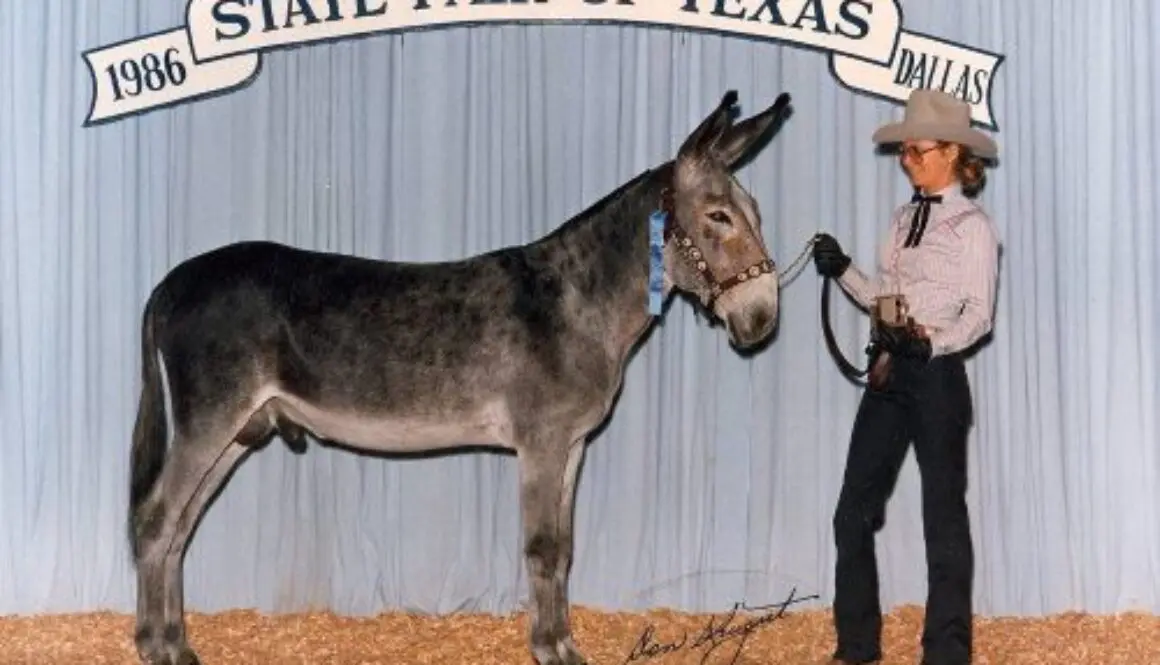
 By Meredith Hodges
By Meredith Hodges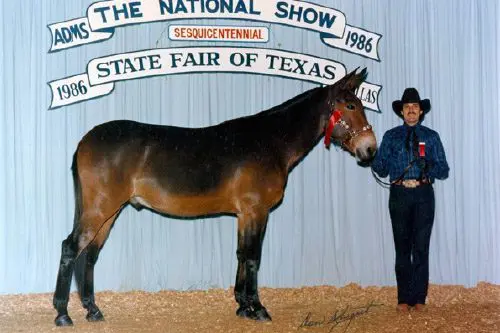 From Loveland, Colorado, it took two days to reach Dallas. The first night, Cliff Rich and Gary Marble were kind enough to arrange for accommodations for us and our Longears at the Equestrian Center in Canyon, just south of Amarillo. The following day, Cliff led us safely into Dallas for the show. Without his help, we would surely have been lost! At the show we were greeted cheerfully and enthusiastically by several A.D.M.S. members and friends whose hospitable contributions made our trip more than worthwhile. Our deepest thanks go to Cliff Rich, Katharine Bradley, Paul and Betsy Hutchins, Darlene Winters, Grady and Wanda Alexander, Jeb and Sue Wilson, Walter Nunn and Keith and Micki Woods. These folks went out of their way to make our experience a pleasant one.
From Loveland, Colorado, it took two days to reach Dallas. The first night, Cliff Rich and Gary Marble were kind enough to arrange for accommodations for us and our Longears at the Equestrian Center in Canyon, just south of Amarillo. The following day, Cliff led us safely into Dallas for the show. Without his help, we would surely have been lost! At the show we were greeted cheerfully and enthusiastically by several A.D.M.S. members and friends whose hospitable contributions made our trip more than worthwhile. Our deepest thanks go to Cliff Rich, Katharine Bradley, Paul and Betsy Hutchins, Darlene Winters, Grady and Wanda Alexander, Jeb and Sue Wilson, Walter Nunn and Keith and Micki Woods. These folks went out of their way to make our experience a pleasant one.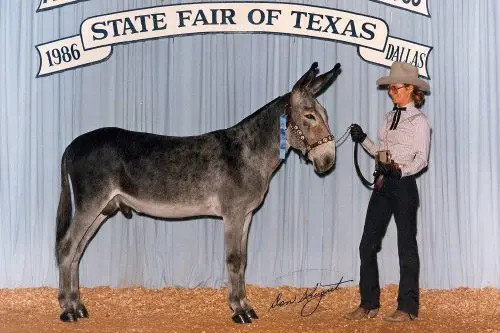 Besides the number of donkey classes made available, there were other things about this show that made it special. Exhibitors were encouraged to decorate their stall areas with photos and facts about mules, donkeys and their farms and ranches. This kind of enthusiasm made for an informative and interesting display for the spectators who strolled through the barn area, helping them to better understand just what was really going on at the show.
Besides the number of donkey classes made available, there were other things about this show that made it special. Exhibitors were encouraged to decorate their stall areas with photos and facts about mules, donkeys and their farms and ranches. This kind of enthusiasm made for an informative and interesting display for the spectators who strolled through the barn area, helping them to better understand just what was really going on at the show.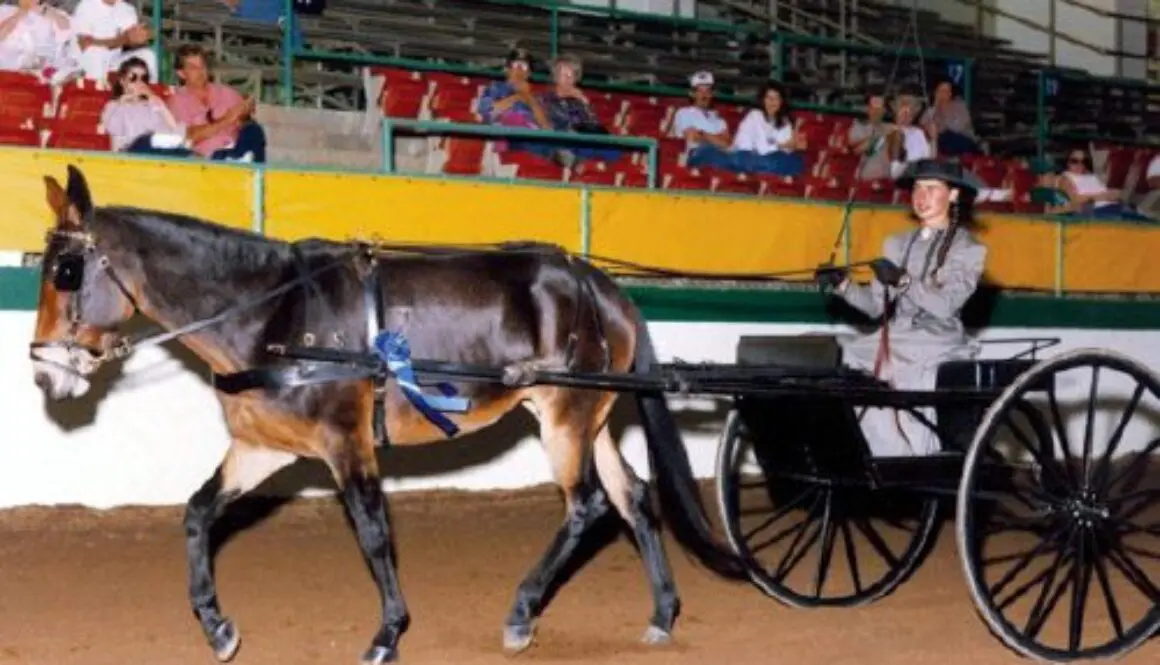
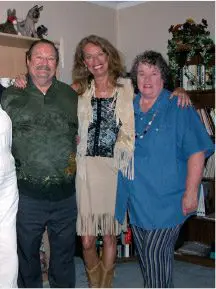 The Donkey & Mule Society of the Carolinas is to be commended on a job well done in the organization and running of this show, with special thanks to Leslie Bruce and Jackie Sanders for their tireless dedication and support. Founders of the American Donkey & Mule Society, Paul and Betsy Hutchins from Denton, Texas, were thrilled with the success of the show while they too made their own personal contributions. Paul’s captivating and humorous comments throughout the show kept the audience perked, while Betsy spent the long hours manning the A.D.M.S. booth, taking new memberships and renewing old ones, selling longears products, and talking Longears with hundreds of eager spectators and exhibitors. Tennessee mule balladeer Marilyn Powell Greene’s melodic voice filled the air, musing on mules and setting an enchanting ambiance to the whole affair. Even I was compelled to travel all the way from Colorado to lend my support to this special Longears event… and I am really glad that I did! I was particularly thrilled that I was able to bring with me my apprentice mule and donkey trainer/breeder, Ruth Elkins, a representative of the British Mule Society! We both had a wonderful time!
The Donkey & Mule Society of the Carolinas is to be commended on a job well done in the organization and running of this show, with special thanks to Leslie Bruce and Jackie Sanders for their tireless dedication and support. Founders of the American Donkey & Mule Society, Paul and Betsy Hutchins from Denton, Texas, were thrilled with the success of the show while they too made their own personal contributions. Paul’s captivating and humorous comments throughout the show kept the audience perked, while Betsy spent the long hours manning the A.D.M.S. booth, taking new memberships and renewing old ones, selling longears products, and talking Longears with hundreds of eager spectators and exhibitors. Tennessee mule balladeer Marilyn Powell Greene’s melodic voice filled the air, musing on mules and setting an enchanting ambiance to the whole affair. Even I was compelled to travel all the way from Colorado to lend my support to this special Longears event… and I am really glad that I did! I was particularly thrilled that I was able to bring with me my apprentice mule and donkey trainer/breeder, Ruth Elkins, a representative of the British Mule Society! We both had a wonderful time!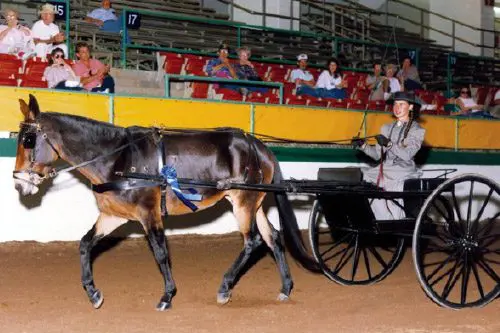 Of particular interest were the driving classes: Single Hitch, Youth Hitch, Multiple, and Parade Hitches, Pleasure Driving, Reinsmanship, Races, and Obstacle classes. There were teams of all different sizes and colors, in beautiful harness, pulling a variety of carts and carriages. Classes were held for both mules and donkeys. As we know, running mules in races of any kind is lucrative at best, but the mules that ran in the harness races at this show were really quite good. Even the donkeys did a respectable job, although there were a couple of them that gave us a chuckle with their deliberate unconcerned attitude during their driver’s enthusiastic “Yee-Hawing” and flailing arms!
Of particular interest were the driving classes: Single Hitch, Youth Hitch, Multiple, and Parade Hitches, Pleasure Driving, Reinsmanship, Races, and Obstacle classes. There were teams of all different sizes and colors, in beautiful harness, pulling a variety of carts and carriages. Classes were held for both mules and donkeys. As we know, running mules in races of any kind is lucrative at best, but the mules that ran in the harness races at this show were really quite good. Even the donkeys did a respectable job, although there were a couple of them that gave us a chuckle with their deliberate unconcerned attitude during their driver’s enthusiastic “Yee-Hawing” and flailing arms!
 By Meredith Hodges
By Meredith Hodges Mules come in as many different sizes and colors as horses, donkeys and ponies. Donkey sizes range from miniatures that are 36″ and under to Mammoths that are 56″ and over. A mule is a miniature if he measures 50″ or less at the withers. Saddle mules come from a wide variety of the larger pony breeds, all light horse breeds and some draft horse breeds. They range in size from 50″ to 72″.
Mules come in as many different sizes and colors as horses, donkeys and ponies. Donkey sizes range from miniatures that are 36″ and under to Mammoths that are 56″ and over. A mule is a miniature if he measures 50″ or less at the withers. Saddle mules come from a wide variety of the larger pony breeds, all light horse breeds and some draft horse breeds. They range in size from 50″ to 72″.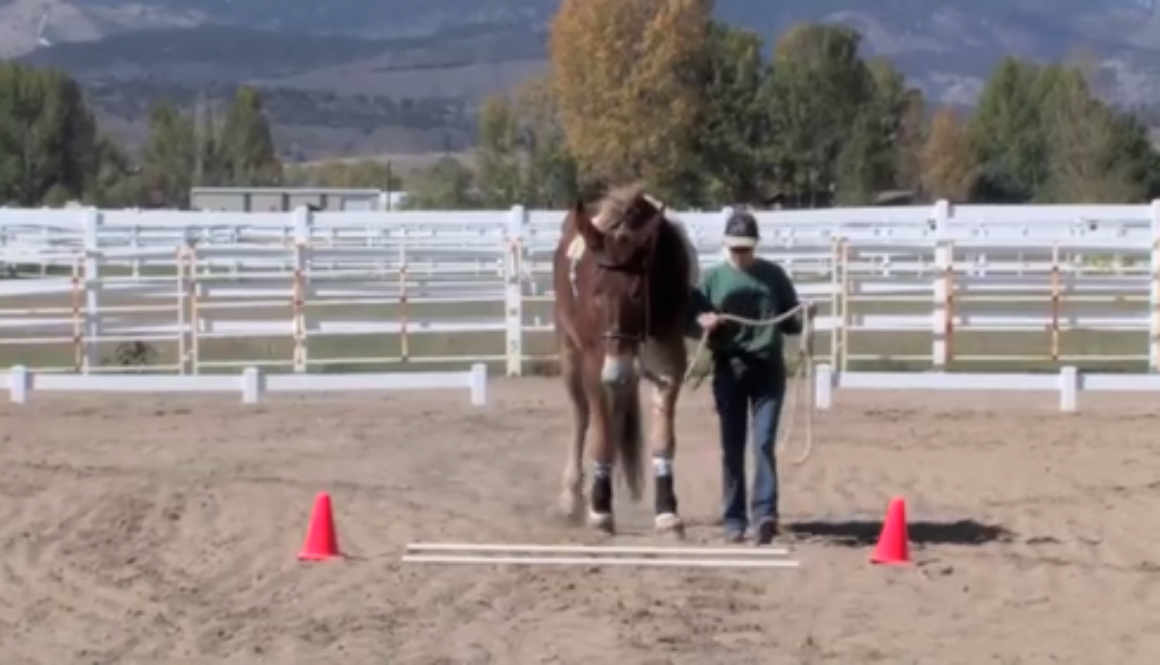
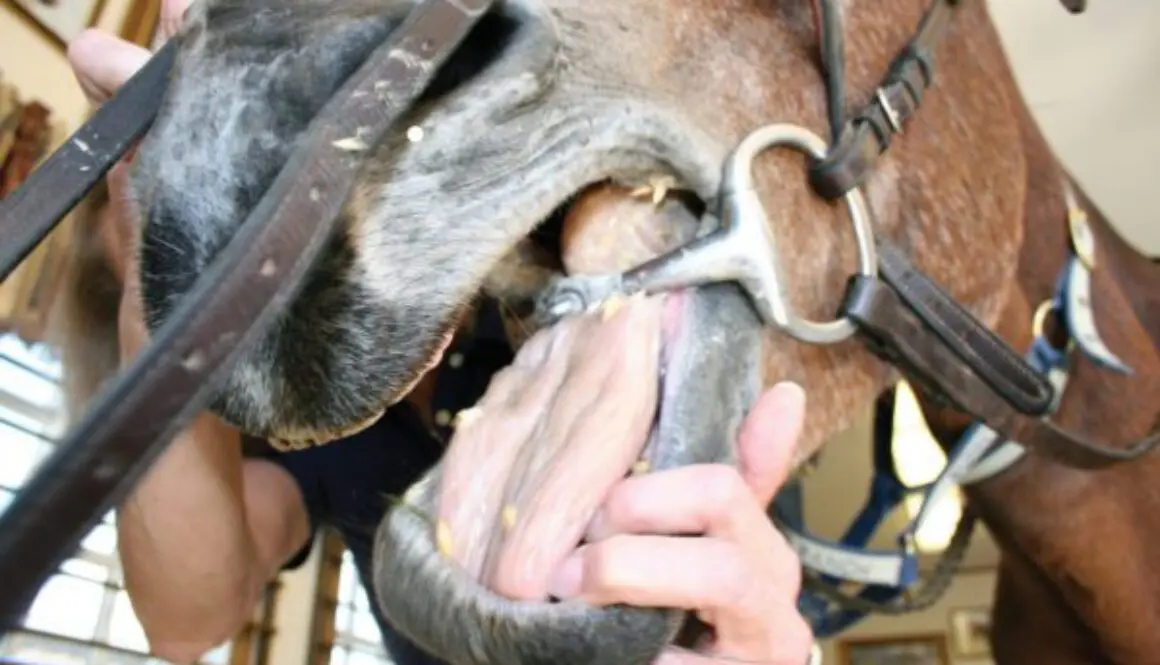
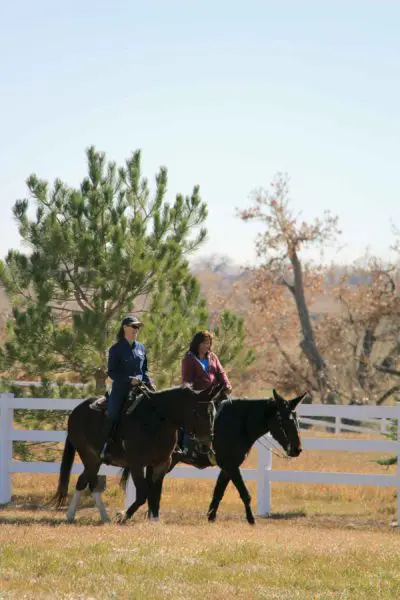 Over the past few decades, through trial and error, we equine owners and trainers have discovered that, when communicating with our equines, harsh bits are not really necessary. Rather, it is safer and more beneficial to use milder tack and equipment, to concentrate on learning correct body language and to give clear cues with our hands, seat and legs to elicit the desired response from our equines.
Over the past few decades, through trial and error, we equine owners and trainers have discovered that, when communicating with our equines, harsh bits are not really necessary. Rather, it is safer and more beneficial to use milder tack and equipment, to concentrate on learning correct body language and to give clear cues with our hands, seat and legs to elicit the desired response from our equines. When it comes to rider/equine communication, bitless and/or brideless techniques do not work as well as the simple, direct rein action of the snaffle bit in concert with your seat and legs.Many people are under the impression that having a bit in the mouth is painful for an equine, and the seeming “nutcracker” action of the snaffle bit when it is in your hands suggests that it might pinch your animal’s tongue when you pull on the reins. The mouthpiece of the snaffle bit actually “breaks” in the middle, allowing it to slide easily across the top of your equine’s tongue. It does not pinch his tongue, but it does put pressure on the corners of his mouth. The snaffle bit is correctly defined as a bit that promotes “direct rein action,” meaning that when you pull right, you go right and when you pull left, you go left. A snaffle bit does not have a shank. If it did have a shank, it would be considered a curb bit, regardless of how short the shank really is (as is the case with a Tom Thumb bit).
When it comes to rider/equine communication, bitless and/or brideless techniques do not work as well as the simple, direct rein action of the snaffle bit in concert with your seat and legs.Many people are under the impression that having a bit in the mouth is painful for an equine, and the seeming “nutcracker” action of the snaffle bit when it is in your hands suggests that it might pinch your animal’s tongue when you pull on the reins. The mouthpiece of the snaffle bit actually “breaks” in the middle, allowing it to slide easily across the top of your equine’s tongue. It does not pinch his tongue, but it does put pressure on the corners of his mouth. The snaffle bit is correctly defined as a bit that promotes “direct rein action,” meaning that when you pull right, you go right and when you pull left, you go left. A snaffle bit does not have a shank. If it did have a shank, it would be considered a curb bit, regardless of how short the shank really is (as is the case with a Tom Thumb bit). Learning to go forward in the beginning of your equine’s training in a snaffle bridle is paramount to properly developing his body so he will learn to carry a rider in a strong and solid frame and in good equine posture. The forward training teaches him to stretch his head and neck forward, to step well underneath his body to propel himself forward, and to elongate his overall frame to keep the vertebrae in his back from becoming compressed and rigid. When he is moving correctly in a straight line, he will have more suspension and flexibility to his gait, and when he turns he will be able to bend easily through his rib cage.
Learning to go forward in the beginning of your equine’s training in a snaffle bridle is paramount to properly developing his body so he will learn to carry a rider in a strong and solid frame and in good equine posture. The forward training teaches him to stretch his head and neck forward, to step well underneath his body to propel himself forward, and to elongate his overall frame to keep the vertebrae in his back from becoming compressed and rigid. When he is moving correctly in a straight line, he will have more suspension and flexibility to his gait, and when he turns he will be able to bend easily through his rib cage. Although it would seem that a bitless bridle could achieve this same end, it has a different action on your equine’s head and neck, which inhibits proper bending through turns. The straight forward motion can be achieved with a bitless bridle. However, reins on a bosal (a type of braided rawhide noseband used with the hackamore-type headstall), bitless bridle reins, and other bitless configurations do not have the same lateral effect on the equine’s head and neck as does the snaffle bit. The equine’s head and neck form two sides of a triangle. The rope reins on a bosal, although lower on the nose of the equine than reins that come from the corners of the mouth, can cause the equine’s head to twist slightly sideways during the turn because, during any directional indication, the rawhide bosal around the nose twists through the rope reins which are both secured together underneath the jaw. The rope reins pull the underside of the bosal in the direction of the turn, but the nosepiece goes the opposite way and can cause your equine to improperly tilt his head through the turns. On bitless bridles, the reins are attached substantially higher than the corners of the equine’s mouth. When you pull on the reins attached higher on the equine’s jaw than where the bit would be as is the case with a halter or bitless bridle, the angle of pull is sharper and more abrupt, since the head side of the “triangle” is so much shorter than the length of the neck. It will cause the equine to try to turn his head too sharply from the poll, which can cause kinks and pain in his neck.
Although it would seem that a bitless bridle could achieve this same end, it has a different action on your equine’s head and neck, which inhibits proper bending through turns. The straight forward motion can be achieved with a bitless bridle. However, reins on a bosal (a type of braided rawhide noseband used with the hackamore-type headstall), bitless bridle reins, and other bitless configurations do not have the same lateral effect on the equine’s head and neck as does the snaffle bit. The equine’s head and neck form two sides of a triangle. The rope reins on a bosal, although lower on the nose of the equine than reins that come from the corners of the mouth, can cause the equine’s head to twist slightly sideways during the turn because, during any directional indication, the rawhide bosal around the nose twists through the rope reins which are both secured together underneath the jaw. The rope reins pull the underside of the bosal in the direction of the turn, but the nosepiece goes the opposite way and can cause your equine to improperly tilt his head through the turns. On bitless bridles, the reins are attached substantially higher than the corners of the equine’s mouth. When you pull on the reins attached higher on the equine’s jaw than where the bit would be as is the case with a halter or bitless bridle, the angle of pull is sharper and more abrupt, since the head side of the “triangle” is so much shorter than the length of the neck. It will cause the equine to try to turn his head too sharply from the poll, which can cause kinks and pain in his neck. To prove the point, try this experiment. Preferably using an untrained animal, take hold of the halter and gently but firmly pull on the halter in an attempt to make him bend his head and neck to the side. The higher position of the halter is like a bitless bridle and you will feel slight tension and resistance to this action before the animal finally complies. Next, gently insert two fingers into one corner of the equine’s mouth while standing at his shoulder and by squeezing and releasing your fingers, ask him to turn his head and neck to the side toward you. If done correctly, without yanking on him, he should give easily to your cue to submit and turn his head and neck. You will notice that he extends his head and neck slightly forward before turning it to the side.
To prove the point, try this experiment. Preferably using an untrained animal, take hold of the halter and gently but firmly pull on the halter in an attempt to make him bend his head and neck to the side. The higher position of the halter is like a bitless bridle and you will feel slight tension and resistance to this action before the animal finally complies. Next, gently insert two fingers into one corner of the equine’s mouth while standing at his shoulder and by squeezing and releasing your fingers, ask him to turn his head and neck to the side toward you. If done correctly, without yanking on him, he should give easily to your cue to submit and turn his head and neck. You will notice that he extends his head and neck slightly forward before turning it to the side. Now try this action on yourself. Stand in good posture and, without extending your neck, turn your head to the side. Do you feel the tension at the brainstem on the back of your neck? Now, stand in good posture, stretch your neck in an upward and forward arc and then look around the turn. Can you now feel the release from tension in the back of your neck? Your equine experiences the same feelings. The shorter angle of the side-pulls and bitless bridles will have a more abrupt pull and can cause some pain, while the longer angle coming from the snaffle bit at the corners of his mouth will allow a smoother and painless response. NOTE: Any bit can be painful to an animal when in the hands of an inexperienced rider who uses only the bit for control.
Now try this action on yourself. Stand in good posture and, without extending your neck, turn your head to the side. Do you feel the tension at the brainstem on the back of your neck? Now, stand in good posture, stretch your neck in an upward and forward arc and then look around the turn. Can you now feel the release from tension in the back of your neck? Your equine experiences the same feelings. The shorter angle of the side-pulls and bitless bridles will have a more abrupt pull and can cause some pain, while the longer angle coming from the snaffle bit at the corners of his mouth will allow a smoother and painless response. NOTE: Any bit can be painful to an animal when in the hands of an inexperienced rider who uses only the bit for control. The equine that has not had this kind of advanced training will possess neither genuinely good posture nor the knowledge of how to respond correctly in an abrupt and unpredictable situation. He will be more apt to be frightened and, as a result, may bolt and run, putting you and everyone around you at risk. However, the equine that is properly and conscientiously taught how to communicate through the snaffle bit will be a safer and more reliable animal to ride and to take into public places. He has learned to stop and wait for cues (communication through the bit) and is less likely to bolt and run if frightened because he understands and trusts the communication coming from his rider. He will now be more correct and solid in his good posture, yielding confidence in his attitude, and he will be a more reliable pleasure and show animal to ride.
The equine that has not had this kind of advanced training will possess neither genuinely good posture nor the knowledge of how to respond correctly in an abrupt and unpredictable situation. He will be more apt to be frightened and, as a result, may bolt and run, putting you and everyone around you at risk. However, the equine that is properly and conscientiously taught how to communicate through the snaffle bit will be a safer and more reliable animal to ride and to take into public places. He has learned to stop and wait for cues (communication through the bit) and is less likely to bolt and run if frightened because he understands and trusts the communication coming from his rider. He will now be more correct and solid in his good posture, yielding confidence in his attitude, and he will be a more reliable pleasure and show animal to ride.

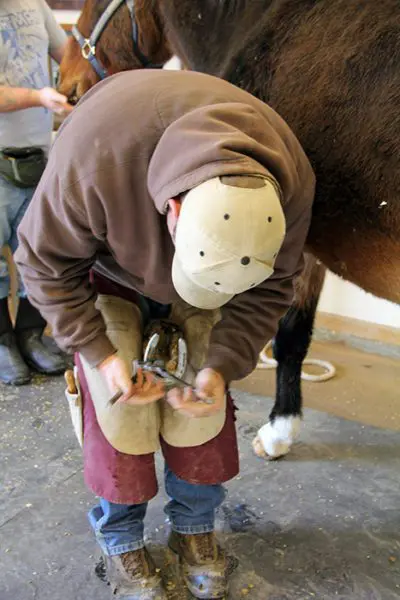 For better or worse, an equine inherits his hooves through his genes. If your mule has inherited good feet—black, oily-looking, and with good shape—then you are fortunate and hoof care and maintenance should be relatively simple. If he has inherited a softer or misshapen foot, you will need to discuss more specialized care with your farrier.
For better or worse, an equine inherits his hooves through his genes. If your mule has inherited good feet—black, oily-looking, and with good shape—then you are fortunate and hoof care and maintenance should be relatively simple. If he has inherited a softer or misshapen foot, you will need to discuss more specialized care with your farrier.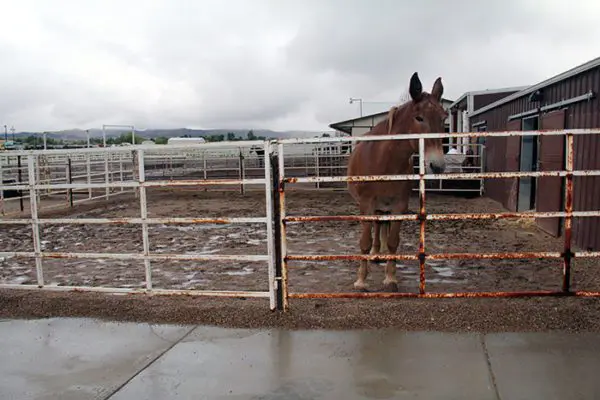 lubricate your mule’s hooves as needed with one of the commercial products available. But before you use an artificial hoof lubricant, first check with your farrier to make sure that it is actually needed. Many people use hoof products too frequently, which can cause hooves to become too soft. When this begins to happen, you will see horizontal rings appear around the hoof wall, and sometimes, vertical lines. Try not to let the hoof get to this point by using lubricants sparingly, but if you see that these rings are beginning to appear, immediately discontinue use of the lubricant and allow the hoof to harden. Then check with your vet to make sure it is not a founder condition. It does not take much to adequately soften the hooves of an animal with rock-hard feet. During the really dry seasons, lubricant application once a week is usually sufficient.
lubricate your mule’s hooves as needed with one of the commercial products available. But before you use an artificial hoof lubricant, first check with your farrier to make sure that it is actually needed. Many people use hoof products too frequently, which can cause hooves to become too soft. When this begins to happen, you will see horizontal rings appear around the hoof wall, and sometimes, vertical lines. Try not to let the hoof get to this point by using lubricants sparingly, but if you see that these rings are beginning to appear, immediately discontinue use of the lubricant and allow the hoof to harden. Then check with your vet to make sure it is not a founder condition. It does not take much to adequately soften the hooves of an animal with rock-hard feet. During the really dry seasons, lubricant application once a week is usually sufficient.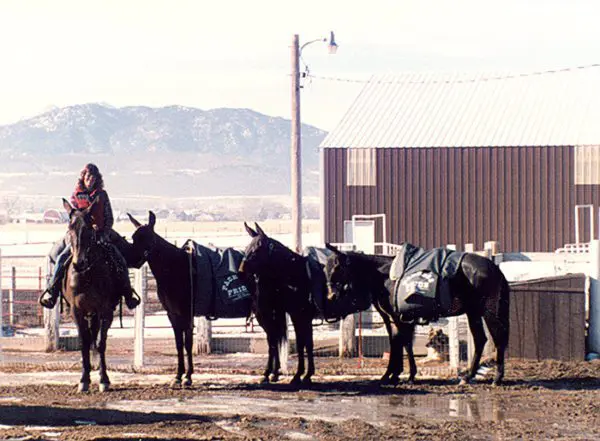 Assuming that your mule has a normal set of dark, healthy hooves, he will probably not need to be shod, as long as he is used strictly for pleasure or only sporadically. However, if you are going to use your mule on excessively rocky or hard ground, you might want to look into getting shoes for him. Mules that repetitively participate in more stressful and demanding activities (such as parades, showing and endurance events) should be shod to protect their feet and to keep them healthy. Prevention of bruising or cracking and maintenance of good foot and leg posture is critical to the equine athlete.
Assuming that your mule has a normal set of dark, healthy hooves, he will probably not need to be shod, as long as he is used strictly for pleasure or only sporadically. However, if you are going to use your mule on excessively rocky or hard ground, you might want to look into getting shoes for him. Mules that repetitively participate in more stressful and demanding activities (such as parades, showing and endurance events) should be shod to protect their feet and to keep them healthy. Prevention of bruising or cracking and maintenance of good foot and leg posture is critical to the equine athlete.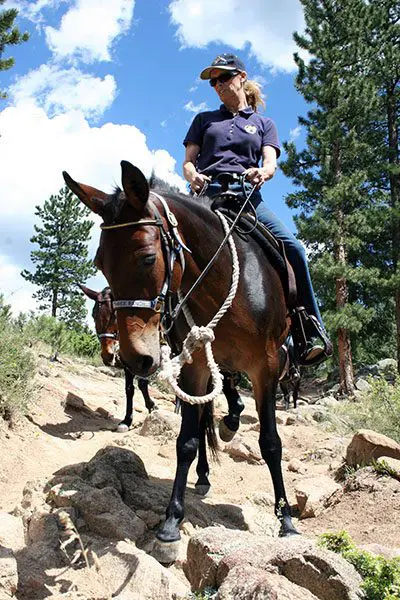 I believe that horses and mules, doing what they would naturally do alone—on terrain that is neither hard nor rocky—do not need to be shod. But mules that are asked to repetitively perform with a human on-board in varying surface situations should be fitted with the proper kind of shoes to help protect them from the additional weight and other demands that will be put upon their bodies. For example, my trail mules wear regular shoes on all four feet when they are being regularly used for trail riding and a variety of other activities, lessening the potential for injury. Then, when there is an occasional misstep on hard ground or rocks or when we trail-ride in the more challenging mountains, the shoes help to absorb some of the shock that would otherwise be absorbed by the hoof itself. It is my experience that young mules (and horses from two to four years of age) bear most of their weight on their front legs until their bodies are carefully and properly conditioned, and this is when you will see the most wear and tear on their feet. Because of this, my young mules that are just beginning saddle training wear regular shoes on the fronts only until their bodies are balanced and their activities clearly defined. Our broodstock, youngsters (under three
I believe that horses and mules, doing what they would naturally do alone—on terrain that is neither hard nor rocky—do not need to be shod. But mules that are asked to repetitively perform with a human on-board in varying surface situations should be fitted with the proper kind of shoes to help protect them from the additional weight and other demands that will be put upon their bodies. For example, my trail mules wear regular shoes on all four feet when they are being regularly used for trail riding and a variety of other activities, lessening the potential for injury. Then, when there is an occasional misstep on hard ground or rocks or when we trail-ride in the more challenging mountains, the shoes help to absorb some of the shock that would otherwise be absorbed by the hoof itself. It is my experience that young mules (and horses from two to four years of age) bear most of their weight on their front legs until their bodies are carefully and properly conditioned, and this is when you will see the most wear and tear on their feet. Because of this, my young mules that are just beginning saddle training wear regular shoes on the fronts only until their bodies are balanced and their activities clearly defined. Our broodstock, youngsters (under three 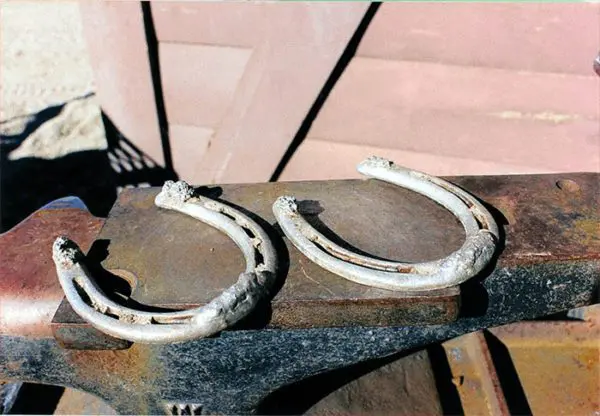 years of age) and equines that are not used under demanding conditions can go barefooted year-round, but they all still get regular trims every six to eight weeks.
years of age) and equines that are not used under demanding conditions can go barefooted year-round, but they all still get regular trims every six to eight weeks.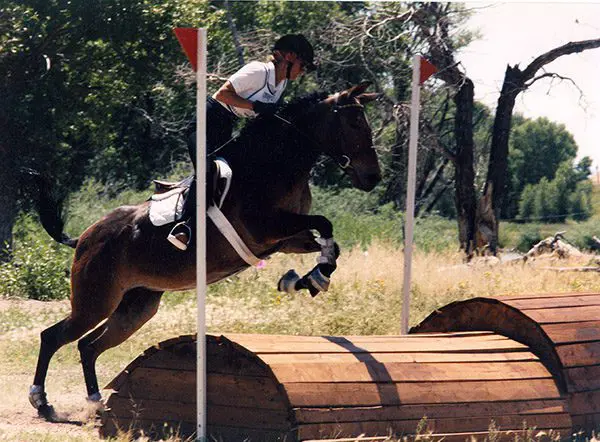 Granted, there are a lot of mules that may not need to be shod, but there are also many that do need shoes, so each individual mule’s feet must be evaluated on a case-by-case basis. Because of this fact, the generalizations that “mules don’t need to be shod” and “all equines should go barefoot” are not always correct. You must take into consideration how your particular mule’s genetics affect his hooves, what he will be used for and how harsh the demands put on him will be on his feet. These important factors will determine whether or not he needs shoes, and if he does need shoes, what kind of shoes will best suit him. And don’t forget to check your mule’s shoes on a regular basis to make sure that all is well and that his shoes are staying on tight, but most of all, that he is comfortable and happy.
Granted, there are a lot of mules that may not need to be shod, but there are also many that do need shoes, so each individual mule’s feet must be evaluated on a case-by-case basis. Because of this fact, the generalizations that “mules don’t need to be shod” and “all equines should go barefoot” are not always correct. You must take into consideration how your particular mule’s genetics affect his hooves, what he will be used for and how harsh the demands put on him will be on his feet. These important factors will determine whether or not he needs shoes, and if he does need shoes, what kind of shoes will best suit him. And don’t forget to check your mule’s shoes on a regular basis to make sure that all is well and that his shoes are staying on tight, but most of all, that he is comfortable and happy.










 Because my equines reacted so well during training, I had no reason to believe that there was anything wrong with my approach until I began showing them. I started to experience resistant behaviors in my animals that I promptly attributed to simple disobedience. I had no reason to believe that I wasn’t being kind and patient until I met my dressage instructor, Melinda Weatherford. I soon learned that complaining about Sundowner’s negative response to his dressage lessons and blaming HIM was not going to yield any shortcuts to our success. The day she showed up with a big button on her lapel that said, “No Whining” was the end of my complaining and impatience, and the beginning of my becoming truly focused on the tasks at hand. I learned that riding through (and often repeating) mistakes did not pose any real solutions to our problems. I attended numerous clinics from all sorts of notable professionals and we improved slowly, but a lot of the problems were still present. Sundowner would still bolt and run when things got a bit awkward, but he eventually stopped bolting once I changed my attitude and approach, and when he was secure in his core strength in good equine posture.
Because my equines reacted so well during training, I had no reason to believe that there was anything wrong with my approach until I began showing them. I started to experience resistant behaviors in my animals that I promptly attributed to simple disobedience. I had no reason to believe that I wasn’t being kind and patient until I met my dressage instructor, Melinda Weatherford. I soon learned that complaining about Sundowner’s negative response to his dressage lessons and blaming HIM was not going to yield any shortcuts to our success. The day she showed up with a big button on her lapel that said, “No Whining” was the end of my complaining and impatience, and the beginning of my becoming truly focused on the tasks at hand. I learned that riding through (and often repeating) mistakes did not pose any real solutions to our problems. I attended numerous clinics from all sorts of notable professionals and we improved slowly, but a lot of the problems were still present. Sundowner would still bolt and run when things got a bit awkward, but he eventually stopped bolting once I changed my attitude and approach, and when he was secure in his core strength in good equine posture. good unless I was careful about the way I used it. Body clipping was much more tolerable for them if I did the hard-to-get places first and saved the general body for last. Standing for long periods of time certainly did not yield a calm, compliant attitude when the more tedious places were left until last. After standing for an hour or more, the animal got antsy when I was trying to do more detailed work around the legs, head, flanks and ears after the body; so I changed the order. Generally speaking, I slowed my pace and eliminated any abrupt movements on my part to give the equine adequate time to assess what I would do next and approached each task very CAREFULLY. The results were amazing! I could now groom, clip bridle paths and fly spray everyone with no halters, even in their turnout areas as a herd. They were all beginning to really trust me.
good unless I was careful about the way I used it. Body clipping was much more tolerable for them if I did the hard-to-get places first and saved the general body for last. Standing for long periods of time certainly did not yield a calm, compliant attitude when the more tedious places were left until last. After standing for an hour or more, the animal got antsy when I was trying to do more detailed work around the legs, head, flanks and ears after the body; so I changed the order. Generally speaking, I slowed my pace and eliminated any abrupt movements on my part to give the equine adequate time to assess what I would do next and approached each task very CAREFULLY. The results were amazing! I could now groom, clip bridle paths and fly spray everyone with no halters, even in their turnout areas as a herd. They were all beginning to really trust me. legs. The core of an equine is at the center of balance in the torso. Similar to bipeds, they need the energy to run freely along the hindquarters and down through the hind legs to create a solid foundation from which to allow the energy in front to rise into suspension to get the most efficient movement. When their weight is shifted too much onto the front end, their ability to carry a rider efficiently and correctly is compromised. To achieve correct energy flow and efficient movement, the animal’s internal supportive structures need to be conditioned in a symmetrical way around the skeletal frame. People can do this by learning to walk with a book on their head and with Pilates exercises, but how can we affect this same kind of conditioning in a quadruped?
legs. The core of an equine is at the center of balance in the torso. Similar to bipeds, they need the energy to run freely along the hindquarters and down through the hind legs to create a solid foundation from which to allow the energy in front to rise into suspension to get the most efficient movement. When their weight is shifted too much onto the front end, their ability to carry a rider efficiently and correctly is compromised. To achieve correct energy flow and efficient movement, the animal’s internal supportive structures need to be conditioned in a symmetrical way around the skeletal frame. People can do this by learning to walk with a book on their head and with Pilates exercises, but how can we affect this same kind of conditioning in a quadruped? the routine and correctness in the execution of the exercises. Since this requires that you be in good posture as well, you will also reap the benefits from this regimen. Along with feeding correctly (explained on my website at www.luckythreeranch.com), these exercises will help equines to drop fat rolls and begin to develop the top line and abdominal strength in good posture. The spine will then be adequately supported to easily accept a rider. He will be better able to stand still as you pull on the saddle horn to mount.
the routine and correctness in the execution of the exercises. Since this requires that you be in good posture as well, you will also reap the benefits from this regimen. Along with feeding correctly (explained on my website at www.luckythreeranch.com), these exercises will help equines to drop fat rolls and begin to develop the top line and abdominal strength in good posture. The spine will then be adequately supported to easily accept a rider. He will be better able to stand still as you pull on the saddle horn to mount. The task at the leading stage is not only to teach them to follow, but to have your equine follow with his head at your shoulder as you define straight lines and gradual arcs that will condition his body symmetrically on all sides of the skeletal frame. This planned course of action also begins to develop a secure bond between you. Mirror the steps of his front legs as you go through the all movements keeping your own body erect and in good posture. Always look in the direction of travel and ask him to square up with equal weight over all four feet every time he stops and reward him. This kind of leading training develops strength and balance in the equine body at the deepest level so strengthened muscles will hold the bones, tendons, ligaments and even cartilage in correct alignment. Equines that are not in correct equine posture will have issues involving organs, joints, hooves and soft tissue trauma. This is why it is so important to spend plenty of time perfecting your techniques every time you lead your equine.
The task at the leading stage is not only to teach them to follow, but to have your equine follow with his head at your shoulder as you define straight lines and gradual arcs that will condition his body symmetrically on all sides of the skeletal frame. This planned course of action also begins to develop a secure bond between you. Mirror the steps of his front legs as you go through the all movements keeping your own body erect and in good posture. Always look in the direction of travel and ask him to square up with equal weight over all four feet every time he stops and reward him. This kind of leading training develops strength and balance in the equine body at the deepest level so strengthened muscles will hold the bones, tendons, ligaments and even cartilage in correct alignment. Equines that are not in correct equine posture will have issues involving organs, joints, hooves and soft tissue trauma. This is why it is so important to spend plenty of time perfecting your techniques every time you lead your equine. Loss of balance will cause stress, and even panic that can result in him pulling the lead rope, lunge line or reins under saddle right out of your hands and running off. This is not disobedience, just fear from a loss of balance and it should not be punished, just ignored and then calmly go back to work. The animal that has had core strength built through leading exercises, lunging on the circle and ground driving in the “Elbow Pull” before riding, will not exhibit these seemingly disobedient behaviors. Lunging will begin to develop hard muscle over the core muscles and internal supportive structures you have spent so many months strengthening during leading training exercises. It will further enhance your equine’s ability to perform and stay balanced in action, and play patterns in turnout will begin to change dramatically as this becomes his habitual way of going. Be sure to be consistent with verbal commands during all these beginning stages as they set the stage for better communication and exceptional performance later. Although you need to spend more time in his beginning training than you might want to, this will also add to your equine’s longevity and use-life by as much as 5-10 years. The equine athlete that has a foundation of core strength in good equine posture, whether used for pleasure or show, will be a much more capable and safe performer than one that has not, and he will always be grateful to YOU for his comfort.
Loss of balance will cause stress, and even panic that can result in him pulling the lead rope, lunge line or reins under saddle right out of your hands and running off. This is not disobedience, just fear from a loss of balance and it should not be punished, just ignored and then calmly go back to work. The animal that has had core strength built through leading exercises, lunging on the circle and ground driving in the “Elbow Pull” before riding, will not exhibit these seemingly disobedient behaviors. Lunging will begin to develop hard muscle over the core muscles and internal supportive structures you have spent so many months strengthening during leading training exercises. It will further enhance your equine’s ability to perform and stay balanced in action, and play patterns in turnout will begin to change dramatically as this becomes his habitual way of going. Be sure to be consistent with verbal commands during all these beginning stages as they set the stage for better communication and exceptional performance later. Although you need to spend more time in his beginning training than you might want to, this will also add to your equine’s longevity and use-life by as much as 5-10 years. The equine athlete that has a foundation of core strength in good equine posture, whether used for pleasure or show, will be a much more capable and safe performer than one that has not, and he will always be grateful to YOU for his comfort.